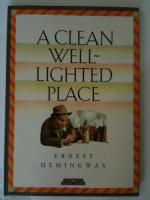|
This section contains 11,116 words (approx. 38 pages at 300 words per page) |

|
SOURCE: “Nada and the Clean, Well-Lighted Place: The Unity of Hemingway's Short Fiction,” in Essays in Literature, Vol. VI, No. 1, Spring, 1979, pp. 91-110.
In the following essay, Hoffman explores Hemingway's thematic concern with “nada,” or nothingness, in his short fiction.
One of his most frequently discussed tales, “A Clean, Well-Lighted Place” is justly regarded as one of the stylistic masterpieces of Ernest Hemingway's distinguished career in short fiction. Not only does it represent Hemingway at his understated, laconic best, but, according to Carlos Baker, “It shows once again that remarkable union of the naturalistic and the symbolic which is possibly his central triumph in the realm of practical aesthetics.”1 In a mere five pages, almost entirely in dialogue and interior monologue, the tale renders a complex series of interactions between three characters in a Spanish café just prior to and immediately after closing: a stoic old waiter, a...
|
This section contains 11,116 words (approx. 38 pages at 300 words per page) |

|


